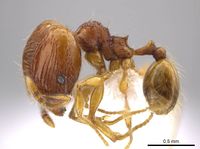Pheidole glomericeps
| Pheidole glomericeps | |
|---|---|

| |
| Scientific classification | |
| Kingdom: | Animalia |
| Phylum: | Arthropoda |
| Class: | Insecta |
| Order: | Hymenoptera |
| Family: | Formicidae |
| Subfamily: | Myrmicinae |
| Tribe: | Attini |
| Genus: | Pheidole |
| Species: | P. glomericeps |
| Binomial name | |
| Pheidole glomericeps Wilson, 2003 | |
This species is only known from type specimens. These were collected at a bait in a subterranean trap, col. W. P. MacKay.
Identification
See the description in the nomenclature section.
Keys including this Species
Distribution
Known from the type locality and from near Turrialba, Cartago Prov., Costa Rica, 550 m. (Wilson 2003)
Latitudinal Distribution Pattern
Latitudinal Range: 18.64° to 8.407045°.
| North Temperate |
North Subtropical |
Tropical | South Subtropical |
South Temperate |
- Source: AntMaps
Distribution based on Regional Taxon Lists
Neotropical Region: Costa Rica, Guatemala, Honduras, Mexico (type locality), Nicaragua, Panama.
Distribution based on AntMaps
Distribution based on AntWeb specimens
Check data from AntWeb
Countries Occupied
| Number of countries occupied by this species based on AntWiki Regional Taxon Lists. In general, fewer countries occupied indicates a narrower range, while more countries indicates a more widespread species. |

|
Estimated Abundance
| Relative abundance based on number of AntMaps records per species (this species within the purple bar). Fewer records (to the left) indicates a less abundant/encountered species while more records (to the right) indicates more abundant/encountered species. |

|
Biology
Castes
Worker
Minor
Images from AntWeb
   
| |
| Worker. Specimen code jtlc000014003. Photographer M. Pierce, uploaded by University of Utah. | Owned by JTLC. |
Nomenclature
The following information is derived from Barry Bolton's Online Catalogue of the Ants of the World.
- glomericeps. Pheidole glomericeps Wilson, 2003: 429, figs. (s.w.) MEXICO.
Unless otherwise noted the text for the remainder of this section is reported from the publication that includes the original description.
Description
Similar in various traits to Pheidole exigua, Pheidole moffetti, Pheidole nana, Pheidole nuculiceps, Pheidole orbica, Pheidole rudigenis, Pheidole sculptior and Pheidole styrax, differing as follows.
Major: outline of head in full-face view circular; antennal scrobes present, anterior fourth of pronotal dorsum, as well as space between eye and antennal fossa, rugoreticulate; promesonotal profile elevated and strongly convex; mesonotal convexity subangulate in side view; petiolar node tapered at apex to a blunt point; postpetiole from above trapezoidal; almost all of mesosoma foveolate.
Minor: eye small and elliptical; promesonotal profile semicircular; occiput broad and weakly concave; petiolar node tapers to point at apex; all of head and mesosoma foveolate.
MEASUREMENTS (mm) Holotype major: HW 0.80, HL 0.80, SL 0.44, EL 0.10, PW 0.38. Paratype minor: HW 0.40, HL 0.44, SL 0.42, EL 0.04, PW 0.24.
COLOR Major and minor: concolorous yellow.
Figure. Upper: holotype, major. Lower: paratype, minor. Scale bars = 1 mm.
Type Material
MEXICO: 10 km south of Palenque, Chiapas, col. William P. MacKay. Museum of Comparative Zoology
Etymology
L glomericeps, spherical head.
References
- Wilson, E. O. 2003. Pheidole in the New World: A dominant, hyperdiverse ant genus. Harvard University Press, Cambridge, MA. (page 428, fig. major, minor described)
- Vázquez-Franco, C.M., Morrone, J.J. 2022. The genus Pheidole (Hymenoptera: Formicidae: Myrmicinae) in Puebla, Mexico. Revista Mexicana de Biodiversidad 93: e933820 (doi:10.22201/ib.20078706e.2022.93.3820).
References based on Global Ant Biodiversity Informatics
- Ahuatzin D. A., E. J. Corro, A. Aguirre Jaimes, J. E. Valenzuela Gonzalez, R. Machado Feitosa, M. Cezar Ribeiro, J. Carlos Lopez Acosta, R. Coates, W. Dattilo. 2019. Forest cover drives leaf litter ant diversity in primary rainforest remnants within human-modified tropical landscapes. Biodiversity and Conservation 28(5): 1091-1107.
- Dattilo W. et al. 2019. MEXICO ANTS: incidence and abundance along the Nearctic-Neotropical interface. Ecology https://doi.org/10.1002/ecy.2944
- Longino J. T. L., and M. G. Branstetter. 2018. The truncated bell: an enigmatic but pervasive elevational diversity pattern in Middle American ants. Ecography 41: 1-12.
- Longino J. et al. ADMAC project. Accessed on March 24th 2017 at https://sites.google.com/site/admacsite/
- Vásquez-Bolaños M. 2011. Lista de especies de hormigas (Hymenoptera: Formicidae) para México. Dugesiana 18: 95-133
- Wilson, E.O. 2003. Pheidole in the New World: A Dominant, Hyperdiverse Genus. Harvard University Press


